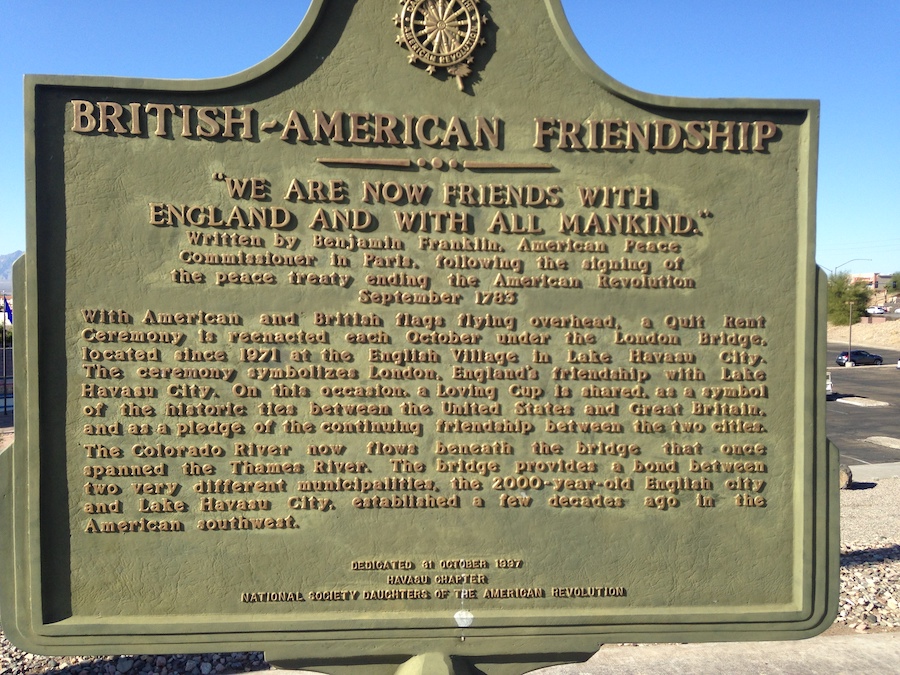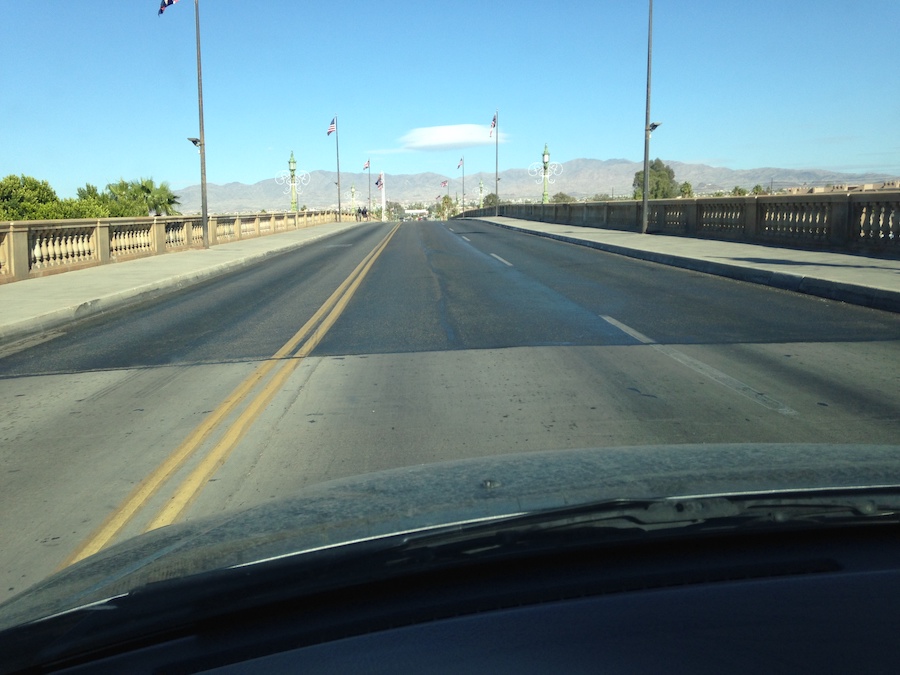
London Bridge is falling down
Falling down, falling down
London Bridge is falling down
My fair lady
London Bridge sold to Lake Havasu City in Arizona:London Bridge was falling down:
In the early 1960s, officials in England made a troubling discovery: London Bridge was falling down. The 1,000-foot span had stood for over 130 years and survived strafing during World War II's London Blitz, but it was unequipped for modern traffic and was slowly sinking into the River Thames at a rate of one inch every eight years. Renovations were deemed impractical, so the City of London resolved to build a wider, more car-friendly replacement. The 19th century granite bridge seemed destined for the junkyard, but a city councilor named Ivan Luckin convinced his colleagues that it might be possible to sell it in the United States.
Negotiations for the purchase proceeded rapidly during the spring of 1968. According to McCulloch, the most difficult part was hashing out a sales price with the City of London authorities. "We poured an awful lot of scotch trying to loosen them up enough to give us some idea of how much they wanted," he told the Chicago Tribune Magazine. Finally, after learning that dismantling the bridge would cost London $1.2 million, McCulloch and Wood decided to offer double that amount. As a sweetener, McCulloch tacked on an additional $60,000—$1,000 for each year old he would be when the bridge reopened at Lake Havasu. In April 1968, for a final price of $2,460,000, Robert McCulloch became the proud owner of the world's largest antique.
https://www.history.com/news/how-london-bridge-ended-up-in-arizona
Several bridges named London Bridge have spanned the River Thames between the City of London and Southwark, in central London.
The current crossing, which opened to traffic in 1973, is a box girder bridge built from concrete and steel.
It replaced a 19th-century stone-arched bridge, which in turn superseded a 600-year-old stone-built medieval structure.
This was preceded by a succession of timber bridges, the first of which was built by the Roman founders of London.
Older London Bridges:
- There is archaeological evidence for scattered Neolithic, Bronze Age and Iron Age settlement nearby, but until a bridge was built there, London did not exist.
- The first London Bridge was built by the Romans as part of their road-building programme, to help consolidate their conquest.
- Around AD 50, the temporary bridge over the Thames was replaced by a permanent timber piled bridge, maintained and guarded by a small garrison.
- The upstream fords and ferries remained in use but the bridge offered uninterrupted, mass movement of foot, horse, and wheeled traffic across the Thames, linking four major arterial road systems north of the Thames with four to the south. Just downstream of the bridge were substantial quays and depots, convenient to seagoing trade between Britain and the rest of the Roman Empire.
- With the end of Roman rule in Britain in the early 5th century, the bridge fell into disrepair.
- The bridge may have been rebuilt by Alfred the Great soon after the Battle of Edington as part of Alfred's redevelopment of the area in his system of burhs, or it may have been rebuilt around 990 under the Saxon king Æthelred the Unready to hasten his troop movements against Sweyn Forkbeard, father of Cnut the Great.
- A skaldic tradition describes the bridge's destruction in 1014 by Æthelred's ally Olaf,[10] to divide the Danish forces who held both the walled City of London and Southwark. The earliest contemporary written reference to a Saxon bridge is c.1016 when chroniclers mention how Cnut's ships bypassed the crossing, during his war to regain the throne from Edmund Ironside.
- Following the Norman conquest in 1066, King William I rebuilt the bridge. The London tornado of 1091 destroyed it, also damaging St Mary-le-Bow. It was repaired or replaced by King William II, destroyed by fire in 1136, and rebuilt in the reign of Stephen.
- After the murder of his former friend and later opponent Thomas Becket, Archbishop of Canterbury, the penitent King Henry II commissioned a new stone bridge in place of the old, with a chapel at its centre dedicated to Becket as martyr.
- Building work began in 1176. Construction was not finished until 1209 during the reign of King John. There were houses on the bridge from the start; this was a normal way of paying for the maintenance of a bridge, though in this case it had to be supplemented by other rents and by tolls.
- The only two collapses occurred when maintenance had been neglected, in 1281 (five arches) and 1437 (two arches).
- The number of houses on the bridge reached its maximum in the late fourteenth century, when there were 140. Subsequently many of the houses, originally only 10 to 11 feet wide, were merged, so that by 1605 there were 91. Originally they are likely to have had only two storeys, but they were gradually enlarged. In the seventeenth century, when there are detailed descriptions of them, almost all had four or five storeys (counting the garrets as a storey); three houses had six storeys. All the houses were shops, and the bridge was one of the City of London's four or five main shopping streets.

[]
[https://commons.wikimedia.org/wiki/File:Claude_de_Jongh_-_View_of_London_Bridge_-_Google_Art_Project.jpg]
- To help improve navigation under the bridge, its two center arches were replaced by a single wider span, the Great Arch, in 1759.
- Demolition of the houses was completed in 1761 and the last tenant departed after some 550 years of housing on the bridge.
- The creation of the Great Arch had weakened the rest of the structure and constant expensive repairs were required in the following decades; this, combined with congestion both on and under bridge, often leading to fatal accidents, resulted in public pressure for a modern replacement.
- In 1799, a competition was opened to design a replacement for the medieval bridge.
- The old bridge continued in use while the new bridge was being built, and was demolished after the latter opened in 1831.
New London Bridge (1831–1967)
- Work began in 1824 and the foundation stone was laid
- In 1896 the bridge was the busiest point in London
- Surveys showed that the bridge was sinking an inch every eight years, and by 1924 the east side had sunk some three to four inches lower than the west side. The bridge would have to be removed and replaced.
New London Bridge Sold rather than destroyed:
- Common Council of the City of London member Ivan Luckin put forward the idea of selling the bridge, and recalled: "They all thought I was completely crazy when I suggested we should sell London Bridge when it needed replacing." Subsequently, in 1968, Council placed the bridge on the market and began to look for potential buyers.
- On 18 April 1968, Rennie's bridge was purchased by the Missourian entrepreneur Robert P. McCulloch of McCulloch Oil for $2,460,000.
- Before the bridge was taken apart, each granite facing block was marked for later reassembly.
- 10,000 tons of granite blocks were shipped via the Panama Canal to California, then trucked from Long Beach to Arizona.
- They were used to face a new, purpose-built hollow core steel-reinforced concrete structure, ensuring the bridge would support the weight of modern traffic.
- It was re-dedicated on 10 October 1971 in a ceremony attended by London's Lord Mayor and celebrities. The bridge carries the McCulloch Boulevard and spans the Bridgewater Channel, an artificial, navigable waterway that leads from the Uptown area of Lake Havasu City.
- The current modern bridge was built in the same location as the old bridge, with the previous bridge remaining in use while the first two girders were constructed upstream and downstream. Traffic was then transferred onto the two new girders, and the previous bridge demolished to allow the final two central girders to be added.
[]
[https://en.wikipedia.org/wiki/London_Bridge]
The head of William Wallace, a Scottish knight and landowner who led the Wars for Scottish Independence, was the first to appear on the gate. Other famous heads on pikes included those of Jack Cade in 1450, Sir Thomas More and Bishop John Fisher in 1535, and Thomas Cromwell in 1540. A German visitor to London in 1598 counted over 30 heads on the bridge. The practice was finally stopped in 1660, following the Restoration of King Charles II.
The purchase included ornate lampposts made from the melted-down cannons captured by the British from Napoleon's army, after the Battle of Waterloo in 1815. Overlooking the Bridgewater Channel, these lampposts line the London Bridge today.
[]
[https://www.golakehavasu.com/london-bridge]
"London Bridge Is Falling Down" (also known as "My Fair Lady" or "London Bridge") is a traditional English nursery rhyme and singing game, which is found in different versions all over the world. It deals with the dilapidation of London Bridge and attempts, realistic or fanciful, to repair it. It may date back to bridge-related rhymes and games of the Late Middle Ages, but the earliest records of the rhyme in English are from the 17th century. The lyrics were first printed in close to their modern form in the mid-18th century and became popular, particularly in Britain and the United States, during the 19th century.
[]
[https://en.wikipedia.org/wiki/London_Bridge_Is_Falling_Down]
By 1962 the 1831 London Bridge was not sturdy enough to carry the increased load of traffic; the bridge was sold by the City of London in April 1968 to make way for its replacement.
The purchaser, Robert P. McCulloch, was an entrepreneur and real estate developer who founded Lake Havasu City. He installed the bridge to attract tourists and retirement home buyers to his properties there.
London Bridge is a bridge in Lake Havasu City, Arizona. It was originally built in the 1830s and formerly spanned the River Thames in London, England. The bridge was purchased by Robert P. McCulloch from the City of London in 1968. McCulloch had exterior granite blocks from the original bridge cut and transported to the United States for use in the construction of a new bridge in Lake Havasu City, a planned community he established in 1964 on the shore of Lake Havasu. The Arizona bridge is a reinforced concrete structure clad in the original masonry of the 1830s bridge. The bridge was completed in 1971 (along with a canal), and links an island in the Colorado River with the main part of Lake Havasu City. The "rededication" of the London Bridge took place on October 10, 1971.
https://en.wikipedia.org/wiki/London_Bridge_(Lake_Havasu_City)


























